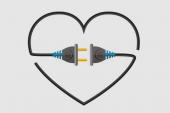Evidence Grows for Conduction-System Pacing as an Alternative to CRT
Still, strong head-to-head data are lacking. “Patients deserve definitive and comparative evidence,” Andrew Krahn says.

SAN FRANCISCO, CA—Attendees of Heart Rhythm 2022 heard results from numerous studies investigating the impact of conduction-system pacing, which includes both His-bundle and left bundle branch (LBB) pacing. That slate of research provided a glimpse of a growing field that still lacks the definitive evidence from randomized trials needed to create a major shift away from cardiac resynchronization therapy (CRT) with biventricular pacing.
Though much of the research presented during the meeting focused on refining techniques, the headliners here were three studies presenting during late-breaking clinical trial sessions. There was a 40-patient randomized pilot trial of LBB versus biventricular pacing in patients with an indication for CRT, along with two retrospective studies: one compared conduction-system pacing (mostly LBB) with biventricular pacing in patients requiring CRT and the other evaluated the performance of rescue LBB pacing in patients with coronary venous lead failure or nonresponse to biventricular pacing.
These studies were meant to “make you pause and ask yourself: could left bundle area pacing compete with or be better than CRT?” Andrew Krahn, MD (University of British Columbia, Vancouver, Canada), incoming president of the Heart Rhythm Society, told TCTMD.
As background, Krahn noted that patients who undergo conventional pacing have a 40% greater risk of developing heart failure over time from frequent ventricular pacing. Before interest in conduction-system pacing, physicians were wary of pacing the right ventricle too much, particularly with solid evidence that CRT with an LV lead is beneficial in patients with heart failure, he added.
Evidence from randomized trials shows that CRT saves lives and improves heart failure and quality of life, and guidelines contain clear indications for the treatment. About 20% to 30% of patients, however, are not helped by CRT, and there are no accurate ways to identify that group, Krahn said.
That opens the door to alternate approaches, like conduction-system pacing. In recent years, there has been growing excitement about the potential for His-bundle pacing, which has actually been around for two to three decades, but since about 2017, interest has shifted toward LBB pacing, according to Krahn. Both techniques aim to restore natural conduction in the heart, as opposed to the artificial resynchronization induced by biventricular pacing, but LBB pacing—the “new kid on the block”—is less challenging, Krahn explained. “For a person who’s already a device-implant-focused individual, this is a small incremental skill that can be learned.”
Building the Evidence Base
There is some evidence from prior studies that His-bundle and LBB pacing, in the hands of skilled early adopters, can improve cardiac function. For example, His-Alternative, a randomized pilot study, showed that among patients with heart failure who required CRT to correct left bundle branch block (LBBB), His-bundle pacing provided improvements in echocardiographic parameters, symptoms, and physical function similar to those seen with biventricular CRT.
At Heart Rhythm 2022, attendees heard the results of a similar pilot trial evaluating LBB pacing, called LBBP-RESYNC, presented by Fengwei Zou, MD (Montefiore Medical Center, Bronx, NY), son of one of the principal investigators, Jiangang Zou, MD, PhD (First Affiliated Hospital, Nanjing Medical University, China). The investigators randomized 40 patients (mean age 63.7; 50% women) with nonischemic cardiomyopathy, LBBB, and an indication for CRT to either LBB pacing or biventricular pacing.
The primary endpoint was the change in LVEF from baseline to 6 months, and this was significantly greater with LBB pacing, increasing by 21.1% versus 15.6% (P = 0.039). LBB pacing also led to greater reductions in LV end-systolic volume and NT-proBNP level.
“With future large-scale RCTs investigating the long-term mortality benefits and the safety of LBB pacing, we think LBB pacing has the potential to become a first-line cardiac resynchronization strategy alongside [biventricular] pacing for heart failure patients with nonischemic cardiomyopathy and left bundle branch block,” Zou said during a press briefing.
Two retrospective studies presented by Pugazhendhi Vijayaraman, MD (Geisinger Heart Institute, Wilkes-Barre, PA), further assessed the impact of conduction-system pacing.
The first, with data from four US centers, included 258 patients who underwent a successful CRT implant and received either LBB pacing (about 65%) or His-bundle pacing (about 35%) and compared them with 219 patients who received biventricular pacing. Overall, mean patient age was 72, and 32% were women. Most patients (54%) had nonischemic cardiomyopathy, 39% had ischemic cardiomyopathy, and 7% had mixed disease.
Conduction-system pacing was associated with a lower risk of death or heart failure hospitalization compared with biventricular pacing (28.3% vs 38.4%; HR 1.52; 95% CI 1.08-2.09), with a greater difference observed in the LBBB subgroup (20.8% vs 35.5%; HR 2.10; 95% CI 1.24-3.53). The better outcomes seen with conduction-system pacing were driven primarily by a significantly lower rate of heart failure hospitalizations.
There is enough here to justify larger clinical trials to answer whether the outcomes achieved with biventricular pacing can be improved even further with conduction-system pacing, Vijayaraman said during a press briefing.
For the second study, also presented as a late breaker, Vijayaraman reported results from a retrospective analysis of rescue LBB pacing in patients who had an indication for CRT but who had a coronary venous lead failure or nonresponse to biventricular pacing. Data on 212 such patients treated across 16 centers came from the International LBBAP Collaborative Study Group.
Rescue LBB pacing was successful in 94% of the cohort, and improvements in a variety of measures were observed through a mean follow-up of 12 months. They included significant reductions in QRS duration, NYHA functional class, LV end-diastolic diameter and volume, and LV end-systolic volume, as well as gains in LVEF, particularly in patients with rescued after a lead failure.
‘Exciting’ Innovation, but Randomized Data Needed
As of right now, Krahn said, conduction-system pacing “is a viable alternative to CRT when the patient doesn’t have a compelling indication for CRT or the patient needs a pacemaker and you’re expecting to do a high proportion of ventricular pacing. I have my own kind of internal indication list right now for when to do this, with the rationale that someone within an EP group should have an interest in this area and be a person who can sort of advocate and develop the expertise to be able to do this.”
Moving forward, the shift away from His-bundle to LBB pacing is likely to continue, Krahn indicated, citing the bigger target for placing the lead and some other advantages with the latter technique. “In a colloquial way, His-bundle pacing is nearly dead,” he said. “So left-bundle pacing will be the general skill. There’s no question about that in my mind.”
For now, the positive data coming out of primarily observational studies need to be interpreted with caution, Krahn said, because the current selection of patients for conduction-system pacing is very nuanced at the patient and physician level.
“We need that prospective and randomized comparative evidence to look at outcomes, and that has to do with procedural complications, and it has to do with things like quality of life and heart function,” Krahn said. He added that there is a debate among researchers designing the next set of trials about how compelling the outcomes need to be change practice. For instance, he said, if procedural complications are lower with conduction-system pacing versus CRT but heart function is equivalent, is that good enough?
“I think most physicians would say, because this is sort of a procedural strategy as opposed to a ‘procedure yes or no’ kind of a question, that some of those intermediate outcomes like quality of life and exercise capacity and heart function are good endpoints,” Krahn said, “and we don’t need 2- or 5-year survival or heart failure hospitalizations and things like that.”
Several clinical trials are underway or being planned, but it’ll be several years before results will start coming out, he said.
Regardless of the outcomes selected, though, definitive randomized comparisons against CRT are a must because the evidence is so robust for CRT, Krahn stressed. “I think patients deserve definitive and comparative evidence to be able to define care.”
Todd Neale is the Associate News Editor for TCTMD and a Senior Medical Journalist. He got his start in journalism at …
Read Full BioSources
Zou J, Fan X. Left bundle branch pacing versus biventricular pacing for cardiac resynchronization therapy: a randomized controlled pilot trial. Presented at: HRS 2022. April 30, 2022. San Francisco, CA.
Vijayaraman P. Clinical outcomes of conduction system pacing compared to biventricular pacing in patients requiring cardiac resynchronization therapy. Presented at: HRS 2022. April 29, 2022. San Francisco, CA.
Vijayaraman P. Rescue left bundle branch area pacing in coronary venous lead failure or non-response to biventricular pacing: results from International LBBAP Collaborative Study Group. Presented at: HRS 2022. April 30, 2022. San Francisco, CA.
Disclosures
- LBBP-RESYNC was sponsored by First Affiliated Hospital, Nanjing Medical University, and Fuwai Hospital, Chinese Academy of Medical Sciences.
- Zou reports no relevant conflicts of interest.
- Vijayaraman reports receiving research, fellowship support, speaker, and consultant fees from Medtronic; receiving consultant fees from Abbott, Biotronik, and Eaglepoint; and holding a patent for a His-bundle pacing delivery tool.
- Krahn reports an inactive prior relationship involving an honoraria or speaking/consulting fee from Medtronic.





Comments